Asking "What is the
best antenna?" is the same as asking "What type of car
should I buy". The majority of the time it will
be the same antenna that
person is using. The descriptions below show what is out
there.
The MAGIC Antenna
The longer the radiator, the better the range. Much like a
butterfly net, the larger the net, the more butterflies
you catch.
Simply put, there is No Magic Antenna, as it is a
passive device made of wire.
Handhelds
Many of today's handheld radios are Dual Band VHF/UHF.
As a result, the OEM antennas supplied are a compromise
between two bands and a convenient size. Which is
the best is determined by your personal preference.
UHF Ham vs. GMRS Handheld Antennas
When selecting a combined HAM / GMRS handheld antenna, you may run into difficulty finding a single antenna that is designed for both
frequencies.
Below is a sweep of a typical dual band handheld antenna.
As shown, the SWR at 450MHz is approximately 2.0:1, however at 462MHz is near infinity.
Although an ad may say 430-480MHz, that usually refers to the receive side.
Field Testing
There are several factors to consider when upgrading and
antenna. Size, SWR, design, etc. An extensive
comparison of 31 different antennas was performed by
Mike W9MDB. These field tests were performed
Over-the-Air. The test results can be found
HERE.
2" Stubby Antenna
(1)
Many short stubby 2" antennas use a small coil to
match TX to a 50 ohm load, not radiate. Don't expect
miracles with this one. Very close range on UHF only.
Regardless of ads and claims,
Do Not use this antenna on VHF. The sweep
below (50-600MHz) shows this is a UHF 440MHz antenna
only. The SWR on VHF is infinity.
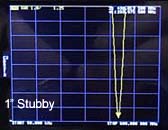
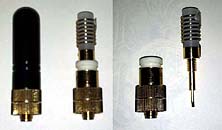
2" Stubby Antenna
with only 1" of radiator
Don't expect miracles. |
2" Stubby Exception
(2)
Exceptions to this is the
Abbree AR-805S and
TIDRADIO TD-805S.
They have a defined notch at 144MHz. On UHF, the tuned
frequency is right at 420MHz.
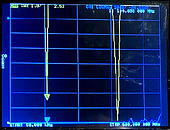
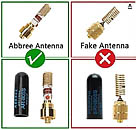
click to enlarge |
2.75" NA-810
Super
flexible. For local
repeaters, hamfests and casual use. I use this
one around the house and at hamfests. SWR is very good
on UHF, but a little high on VHF. Personal experience with these is they will
get warm on long transmissions. Use with caution for
short range. The sweep at the bottom of the page shows that these are definitely
dual band.
6.5" A-V85
This is the standard antenna from which many are
compared. It's the basic OEM antenna found on many dual
band handhelds. It does well but does not offer anything
in the way of gain. For that you will need an upgrade,
but for everyday use, it's not a bad little antenna.
8.0" NA-701 / 701C
This is the favorite replacement antenna for many of the
original OEM antennas. The original UV5R antenna (A-V85)
does well as a basic antenna, left room for improvement. The 701 is a convenient length and
has much better
performance on both VHF and UHF. This is the minimum of
the good replacement antennas.
The 701C is a commercial version.
8.5" NA-717
This is a new entry to the Nagoya line of antennas.
Measuring in at a half inch longer than the NA-701, the
big advantage is its extreme flexibility. If you
carry your handheld clipped onto your belt and don't
like the antenna jabbing you in the side, this may be
one to consider.
15" NA-771
(Review)
The NA-771 seems to be the overall dual band antenna performance
favorite of the
group. A 15" antenna
is a bit larger if you're trying to carry
your handheld on your hip, but in the field it's a great
antenna.
15" NA-771G (GMRS)
(Review)
The 771G is cut specifically for the GMRS handheld.
Here's where the SWR is a major factor. The standard
Ham 771
has a flat SWR at 446MHz, yet nears infinity at 465MHz,
where the 771G is right on
target for GMRS. (Sweep shown above at Ham vs. GMRS.)
Again, a 15" antenna
tends to be a bit larger, but in the field it's great.
15" NA-771R
(Review)
This is the retractable version of the NA-771. On
the air tests show equal performance to the 771 with the
benefit of the collapsible element. With the
antenna in the retracted state, it will still receive
most signals, but you Must have it fully extended when
transmitting to avoid damage to your radio. A good
antenna for hamfests or out in the field.
16" NA-24J
(Review)
This antenna is the lighter, thinner and more flexible
version of the NA-771 above. Much like the NA-717
above, a good option if radio is clipped to your belt.
17.7" NA 320A
TRI-Band Antenna (Review)
If you have a UV-82X, UV-5X3, or any of the new tri-band
(2m/1.25m/70cm) transceivers, you may want to consider
this one. It's a little longer than a NA-771, but the
performance on all 3 bands is excellent.
Loop Antenna - TWAYRDIO DC143
Here's something a little different. The sweep shows
2.0:1 on 144MHz and 3.0:1 on 444MHz. Although it has a
unique design, I really noticed no difference over the
stock antenna.
My original thought was possibly directional for Fox
Hunts or cross polarization. Unfortunately, not to be.
CAUTION:
The next group of antennas described exceed 20" in
length. When using these, there aretwo important things
to consider.
- The antenna MUST be fully
seated to the radio. If there is the slightest gap
between the radio and the antenna base, the weight and
movement of the
antenna could easily fracture the SMA solder connection
or SMA connector.
- In most cases the antenna size and weight will
offset the radio's center of balance and easily cause
the radio fall over.
34" Nagoya AL-800
This antenna is a very top heavy and cumbersome. The
center loading coil adds to its imbalance. Although
the antenna works well, it must be fully extended.
40" MFJ 1714S (VHF single
band)
Yes, you read it right, a 40" antenna. It is a full 1/2
wave antenna for strictly VHF. Field tests show it is
excellent antenna, but it's size could be a definite
limitation.
MFJ 1714S
54" Diamond RH205 (VHF single
band)
Now, are you ready for the ultimate. You read it
right. A 54" antenna for your 4" radio. A full 5/8
wavelength antenna for 2 meters. The antenna
termination is a BNC Male, so for most handhelds it will
require an adapter. If you truly feel that size matters,
this may be the one.
19" 30" and 43" 'Tactical Antennas'
These antennas mimic the military style folding antenna.
Although the antenna can be folded, it
must be fully
extended perform properly. (see below) The reviews on these are
good as far as SWR and performance, but there is total
agreement on one thing. Don't try to stand your radio up
on a desk with the 43" antenna extended.
The test below was run with the19" version.
It shows the difference between the antenna fully
extended vs. folded.
- Fully extended, the antenna
shows distinct notches for both VHF and UHF.
- When folded,
it
shows the antenna is untuned. VHF SWR at 7.0:1, nearing
infinity.
This applies to any
antenna not extended to its full length.
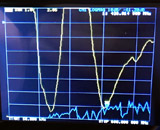
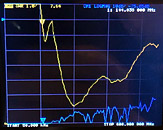
Fully extended vs. Folded |
Thread Depth
Also, be aware that some antenna require different
length threads. It the threads are too short, they may
not make a good connection. If they are too long, they
may not fit flush. Make sure the antenna is made for
your radio.
Thread_Link
Counterfeit Antennas
To start, here is the Genuine/Fake comparison directly from the
Nagoya website.
My personal experience
Yes, they are out there. These antennas are made to look
like genuine antennas, and even copy the manufacturers
name.
I purchased what was supposed to be a
Diamond 771 antenna from an online auction. When it
arrived, there were two obvious packaging errors.
- The
packaging read RH-771 (SMA version should read
SRH-771.
- The tiny diamond in the fake's logo's letter 'E' was actually
a small triangle. Also the packaging on the fake was
smooth plastic as compared to textured.

Click to view
Detail |
I ran a sweep on the Fake NA-771 and it showed two
very distinct tuning notches of 1.7:1 SWR. Unfortunately
their frequencies were at 248MHz and 564 MHz.
At standard ham frequencies, the SWR was Infinity.
Enough to actually damage a handheld. Needless to say, this one
went into the trash.
Fake NA771 sweep
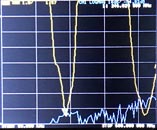
248 MHz and 564
MHz |
All Antennas are Not Created Equal
A direct comparison example between two
"identical" antennas.
Trusted Brands and Vendors
My personal antennas are Nagoya, but Retech, Diamond,
etc. are all excellent brands. Just make sure you
purchase from a trusted vendor to avoid disappointment
and possible damage to your radio.
What is a
Tiger Tail
A Counterpoise or "Tiger Tail" can serve as a nice
addition to your radio's performance, especially when operating in the
field. It is low cost and simple to construct. The
purpose of the TT is to the have the handheld antenna
function more like a vertical dipole. This will add
additional gain to both the transmit and receive
performance.
-
An excellent description of the TT construction can be
found
in this
Video created by Larry WD0AKX.
Nagoya Antenna Feature Chart -
Link Here
Conclusion
The absolute Best antenna is the one that meets your
needs. There is No Magic Antenna. And by all
means, purchase from a reputable dealer.
Amazon, BTech and eBay links for the above antennas:
|